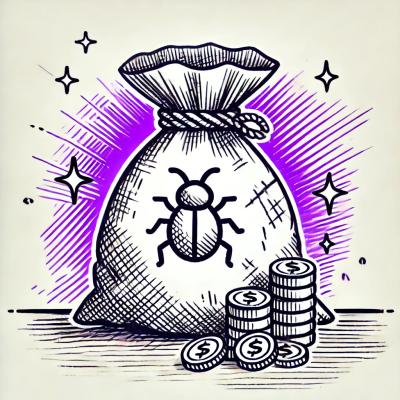
Research
Security News
Malicious npm Packages Use Telegram to Exfiltrate BullX Credentials
Socket uncovers an npm Trojan stealing crypto wallets and BullX credentials via obfuscated code and Telegram exfiltration.
Mutagen Helper allow you to define Mutagen synchronisation sessions inside a configuration file on directories you want to synchronise. Created sessions are marked with a session name and a project name that makes them easier to manage.
Mutagen Helper allow you to define Mutagen synchronisation sessions inside a configuration file on directories you want to synchronise. Created sessions are marked with a session name and a project name that makes them easier to manage.
Mutagen was written on earlier version of Mutagen. Mutagen 0.10+ brings a new
Orchestration feature that makes most mutagen-helper features
redundant, so you should first give a try to this new feature.
I'm still working with Mutagen's author Jacob Howard to embed as much as mutagen-helper use cases as possible into mutagen's core (mutagen-io/mutagen#109).
or
pip install mutagen-helper on Python 3.6+Install mutagen as usual (version 0.10+), and make it available in the user PATH or define MUTAGEN_HELPER_MUTAGEN_BIN environment
variable to the path of the mutagen binary as an alternative (ie: C:\tools\mutagen\mutagen-helper.exe).
Create .mutagen-helper.yml file inside some local directory you want to synchronize and set beta property to the
destination of the synchronisation.
project_name: 'helper-project' # Optional, it will fallback to directory name if not defined
beta: 'root@192.168.1.100:/home/vagrant/projects' # Beta side of the synchronisation
options: # Options can be provided
sync-mode: two-way-resolved
default-file-mode-beta: 664
default-directory-mode-beta: 775
default-owner-beta: vagrant
default-group-beta: vagrant
ignore-vcs: True
ignore:
- node_modules/
- vendor/
Mutagen Helper appends the project_name to the beta URL. It means that this
directory will be synchronised to /home/vagrant/projects/helper-project.
Run mutagen-helper up from the project directory.
Run mutagen-helper list to see which sessions are running. Output of this command match mutagen list output,
but as JSON and with additional synchronisation helper properties like Project name, Session name and
Configuration file.
Run mutagen-helper --help to check other available commands.
Usage: __main__.py [OPTIONS] COMMAND [ARGS]...
Main command group :return:
Options:
--version Show the version and exit.
-v, --verbose Add more output
-s, --silent No output at all
-h, --help Show this message and exit.
Commands:
up Creates and starts a new synchronization sessions
down Permanently terminates synchronization sessions
pause Pauses synchronization sessions
flush Flush synchronization sessions
resume Resumes paused or disconnected synchronization sessions
list Lists existing synchronization sessions and their statuses
You may up multiple projects at the same time if all your projects lies in the same directory.
C:\workspace
|- project1
|- .mutagen-helper.yml
|- ...
|- project2
|- .mutagen-helper.yml
|- ...
|- project3
|- .mutagen-helper.yml
|- ...
mutagen-helper up --path C:\workspace
or
cd C:\workspace
mutagen-helper up
or
export MUTAGEN_HELPER_PATH=C:\workspace
mutagen-helper up
Those command will create all mutagen sessions defined in .mutagen-helper.yml of each subdirectories of C:\workspace.
You may use environment variable expansion, with ${VARIABLE} syntax like in bash. Your can set a default value if
variable is not defined with ${VARIABLE:-default}.
Your may also define multiple sessions under a sessions key. Properties defined at root of the configuration file
will be inherited by each session.
You may also give names to sessions for them to be identified with precision, but keep in mind that changing name on running sessions could cause problem as they are used to find out the real mutagen session id.
beta: '${DOCKER_DEVBOX_MUTAGEN_BETA:-root@192.168.1.100:/home/vagrant/projects}'
sessions:
- options:
name: 'partial-watch-alpha'
sync-mode: two-way-resolved
default-file-mode-beta: 664
default-directory-mode-beta: 775
default-owner-beta: vagrant
default-group-beta: vagrant
ignore-vcs: True
ignore:
- node_modules/
- vendor/
max-staging-file-size: 1MB
watch-mode-beta: no-watch
- options:
name: 'full-no-watch'
sync-mode: two-way-resolved
default-file-mode-beta: 664
default-directory-mode-beta: 775
default-owner-beta: vagrant
default-group-beta: vagrant
max-staging-file-size: 1MB
watch-mode: no-watch
It's possible to define a single configuration file for multiple projects with projects key. It supports the same
inheritance mechanism as with sessions.
beta: '${DOCKER_DEVBOX_MUTAGEN_BETA:-root@192.168.1.100:/home/vagrant/projects}'
options:
sync-mode: two-way-resolved
default-file-mode-beta: 664
default-directory-mode-beta: 775
default-owner-beta: vagrant
default-group-beta: vagrant
projects:
- path: C:\workspace\project1
- path: C:\workspace\project2
- path: C:\workspace\project3
beta: beta: 'vagrant@192.168.1.100:/home/vagrant/projects'
options:
sync-mode: two-way-resolved
default-file-mode-beta: 600
default-directory-mode-beta: 700
You can automate the configuration of a directory containing many project. Create a .mutagen-helper.yml file inside
the parent of those directories, and set auto_configure.
auto_configure: True
C:\workspace
|- .mutagen-helper.yml # Auto configure YAML file
|- project-dev1 # Projects without any mutagen-helper configuration file
|- ...
|- project-dev2
|- ...
|- project-dev2-stage
|- ...
|- project-prod1
|- ...
This will create synchronisation projects for each subdirectory (project-dev1, project-dev2, project-dev2-stage and
project-prod1).
You can set include and exclude to disable auto configure feature for some subdirectories only, and other property
you can normally use on projects and sessions
beta: '${DOCKER_DEVBOX_MUTAGEN_BETA:-root@192.168.1.100:/home/vagrant/projects}'
auto_configure:
include:
- '*-dev*'
exclude:
- '*-stage'
options:
sync-mode: two-way-resolved
default-file-mode-beta: 644
default-directory-mode-beta: 755
default-owner-beta: vagrant
default-group-beta: vagrant
this will create a synchronisation project for project-dev1 and project-dev2 (include has priority other exclude).
By default, if a configuration file is present in a project directory, it is still used to create the
synchronisation project. You can ignore those configuration files with ignore_project_configuration to let auto
configure create the synchronisation project on his own.
beta: '${DOCKER_DEVBOX_MUTAGEN_BETA:-root@192.168.1.100:/home/vagrant/projects}'
auto_configure:
ignore_project_configuration: True # It can also be a list of glob for project names to ignore
options:
sync-mode: two-way-resolved
default-file-mode-beta: 644
default-directory-mode-beta: 755
default-owner-beta: vagrant
default-group-beta: vagrant
Some properties have default values, based on environment variables if defined.
alpha
MUTAGEN_HELPER_ALPHA environment variable, or.mutagen-helper.yml residesbeta:
MUTAGEN_HELPER_BETA environment variable, or.mutagen-helper.ymlappend_project_name_to_beta:
MUTAGEN_HELPER_APPEND_PROJECT_NAME_TO_BETA, orTrueMUTAGEN_HELPER_PATH environment variable can be set to a path to make mutagen-helper load
configuration from this path by default instead of current working directory. (--path option can still be used)
FAQs
Mutagen Helper allow you to define Mutagen synchronisation sessions inside a configuration file on directories you want to synchronise. Created sessions are marked with a session name and a project name that makes them easier to manage.
We found that mutagen-helper demonstrated a healthy version release cadence and project activity because the last version was released less than a year ago. It has 1 open source maintainer collaborating on the project.
Did you know?

Socket for GitHub automatically highlights issues in each pull request and monitors the health of all your open source dependencies. Discover the contents of your packages and block harmful activity before you install or update your dependencies.

Research
Security News
Socket uncovers an npm Trojan stealing crypto wallets and BullX credentials via obfuscated code and Telegram exfiltration.

Research
Security News
Malicious npm packages posing as developer tools target macOS Cursor IDE users, stealing credentials and modifying files to gain persistent backdoor access.

Security News
AI-generated slop reports are making bug bounty triage harder, wasting maintainer time, and straining trust in vulnerability disclosure programs.